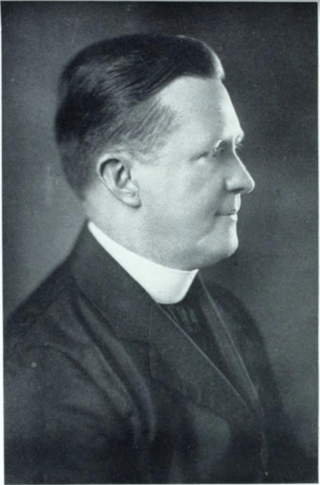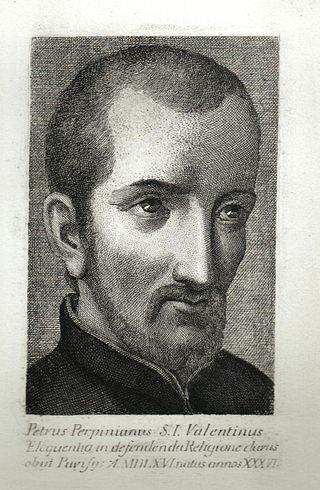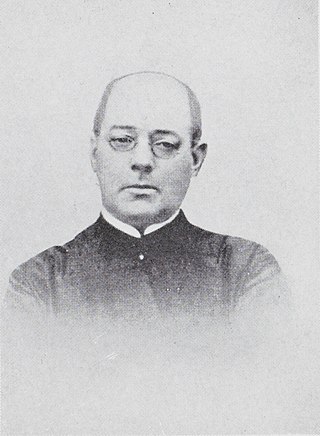
The Society of Jesus, also known as the Jesuit Order or the Jesuits, is a religious order of clerics regular of pontifical right for men in the Catholic Church headquartered in Rome. It was founded in 1540 by Ignatius of Loyola and six companions, with the approval of Pope Paul III. The society is engaged in evangelization and apostolic ministry in 112 nations. Jesuits work in education, research, and cultural pursuits. Jesuits also conduct retreats, minister in hospitals and parishes, sponsor direct social and humanitarian ministries, and promote ecumenical dialogue.

Claudio Acquaviva, SJ was an Italian Jesuit priest. Elected in 1581 as the fifth Superior General of the Society of Jesus, he has been referred to as the second founder of the Jesuit order.

Jan Philipp Roothaan, SJ was a Dutch Jesuit, elected twenty-first Superior-General of the Society of Jesus.

Antonio Possevino was a Jesuit protagonist of Counter Reformation as a papal diplomat and a Jesuit controversialist, encyclopedist and bibliographer. He was the first Jesuit to visit Muscovy, Sweden, Denmark, Livonia, Hungary, Pomerania, and Saxony in amply documented papal missions between 1578 and 1586 where he championed the enterprising policies of Pope Gregory XIII.

The Classical Gymnasium is a gymnasium high school situated in Zagreb, Croatia. It was founded by the Society of Jesus in 1607. In its first year it had 260 students and it operated on the basis of the Jesuit programme "Ratio atque institutio studiorum societatis Jesu".

Manuel Álvares was a Jesuit educator in Portugal. His Latin grammar, De institutione grammatica libri tres, is considered one of the worldwide most influential Latin grammars ever.
The Monumenta Historica Societatis Iesu (MHSI) is a collection of scholarly volumes on critically edited documents on the origin and early years of the Society of Jesus, including the life and writings of St Ignatius of Loyola.
Georg Michael Pachtler was a German Jesuit and educational writer.

Miguel Anselmo Azcona Bernad, S.J. was a Filipino Jesuit priest, educator, linguist, critic, academic, historian, author, journalist and editor. Son of Misamis Mayor and Misamis Occidental Governor Don Anselmo Bernad, he entered the Society of Jesus on June 7, 1932 and was ordained March 24, 1946 in the Fordham University Church. He was editor-in-chief of Philippine Studies from 1956 to 1959 and founder of Kinaadman Journal Research Office in 1979.

Ignatius of Loyola, venerated as Saint Ignatius of Loyola, was a Spanish Basque Catholic priest and theologian, who, with six companions, founded the religious order of the Society of Jesus (Jesuits), and became its first Superior General, in Paris in 1541.
Cypriano Soarez y Herrera, S.J. (1524–1593) was a sixteenth-century Spanish Jesuit who wrote De Arte Rhetorica, the first Jesuit rhetoric textbook.
The Universidad de San Ignacio was a university in the city of Manila which existed during the Spanish colonial era in the Philippines. It was founded in 1590 and is one of the earliest educational institutions built by Europeans in East Asia when it was established by Spanish Jesuits headed by Fr. Antonio Sedeño, S.J. The school ceased its existence following the expulsion of the Jesuits in the archipelago in 1768.

Eloquentia perfecta, a tradition of the Society of Jesus, is a value of Jesuit rhetoric that revolves around cultivating a person as a whole, as one learns to speak and write for the common good. Eloquentia perfecta is a Latin term which means "perfect eloquence". The term connotes values of eloquent expression and action for the common good. For Jesuits, the term eloquentia perfecta was understood as the joining of knowledge and wisdom with virtue and morality.

Rodrigo de Arriaga was a Spanish philosopher, theologian and Jesuit. He is known as one of the foremost Spanish Jesuits of his day and as a leading representative of post-Suárezian baroque Jesuit nominalism. Accordig to Richard Popkin, Arriaga was “the last of the great Spanish Scholastics”.

The Sankt-Ansgar-Schule is a private secondary school in Hamburg, Germany. It was founded in 1946 as the only boys' school by the Society of Jesus, an order of the Catholic Church, in the State of Hamburg. The school was named after Saint Ansgar who Christianized Northern Germany in the 9th century. The motto of the SAS is: bonitatem et disciplinam et scientiam doce me, domine which is engraved above the official main entrance. In 1978, it became a co-educational school. The Jesuits gave up running the school in 1993 themselves but the Sankt-Ansgar-Schule has remained a member of the association of Jesuit schools and still follows all of the order's rules for their educational institutions. Currently, the archbishopric of Hamburg formerly runs the school.

Jerome Daugherty was an American Catholic priest and Jesuit who served in many different capacities at Jesuit institutions throughout the northeast United States, eventually becoming president of Georgetown University in 1901. Born in Baltimore, he was educated at Loyola College in Maryland, before entering the Society of Jesus and becoming a member of the first class at Woodstock College. He then taught various subjects, including mathematics, Latin, Ancient Greek, rhetoric, and the humanities in Massachusetts, New York City, and Washington, D.C., and served as minister at many of the institutions there.

Joseph A. Canning was an American Catholic priest and Jesuit. Born in New York City, he studied at St. Francis Xavier High School, before entering the Society of Jesus in 1898. He continued his studies at St. Andrew-on-Hudson and Woodstock College. He was ordained a priest in 1915, and spent the next eight years as a missionary in Jamaica.
Pedro Juan Núñez was a Valencian humanist and educator active during the Spanish Golden Age. He is famous for his rhetorical treatises based on Hermogenes' rhetorical works.

Pedro Juan Pepinyá, S.J. was a Spanish Jesuit humanist who contributed to the development of the Jesuit Cursus Conimbricensis commentaries on Aristotle and who revised Cypriano Soarez' De arte rhetorica.

Edward Victor Boursaud was an American Catholic priest and Jesuit who was the president of Boston College from 1884 to 1887. Raised in New York City and France, he studied at Mount St. Mary's College in Maryland before entering the Society of Jesus in 1863. For the next 18 years, he studied and taught at Jesuit institutions, including Boston College, Georgetown College, and Woodstock College, as well as the novitiate in Frederick, Maryland. In 1881 and 1887, he served three-year terms in Italy as the assistant secretary to the Jesuit Superior General for the English-speaking world.















